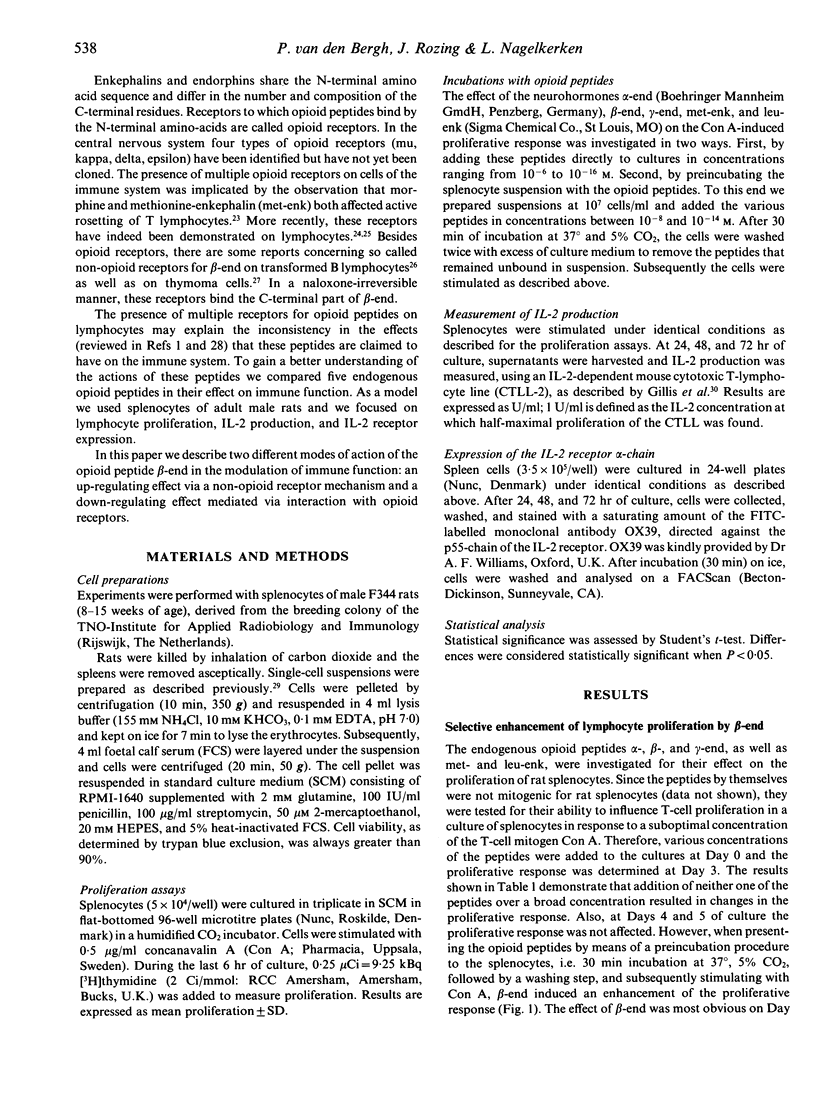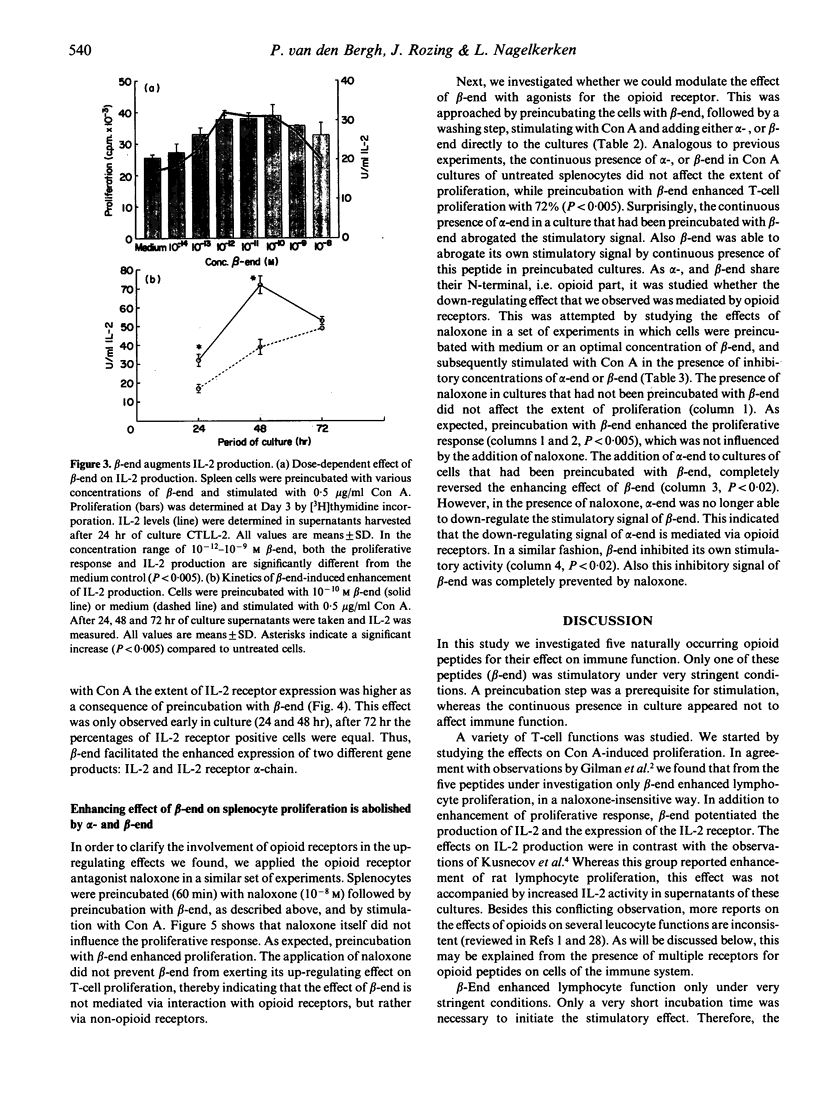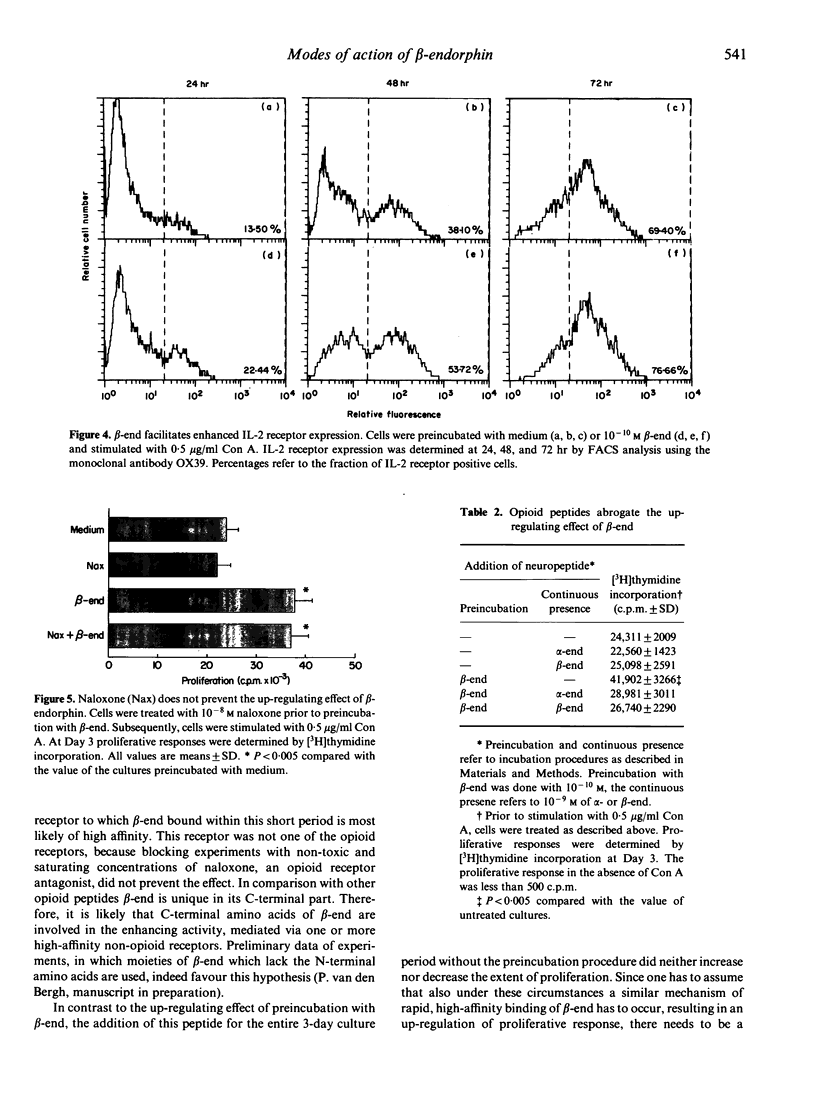Abstract
Five opioid peptides (alpha-, beta-, and gamma-endorphin, methionine- and leucine-enkephalin) were tested for their effect on the concanavalin A-induced proliferative response of splenocytes of adult male F344 rats. The continuous presence of these opioid peptides during culture of T cells did not affect proliferation. However, 30 min of preincubation with beta-endorphin (beta-end), but not with the other opioid peptides, resulted in a dose-dependent enhancement of proliferation of 50-100%. This potentiating effect of beta-end on proliferation was preceded by an increase in the production of interleukin-2 (IL-2) and in the extent of IL-2 receptor expression. The stimulatory effect of beta-end was not prevented by naloxone, indicating that classical opioid receptors were not involved. The continuous presence of beta-end (or alpha-end) in cultures of cells that had been preincubated with beta-end completely abolished the stimulatory effect, pointing towards the potential of beta-end to regulate T-cell function via different mechanisms.
Full text
PDF






Selected References
These references are in PubMed. This may not be the complete list of references from this article.
- Apte R. N., Oppenheim J. J., Durum S. K. Beta-endorphin regulates interleukin 1 production and release by murine bone marrow macrophages. Int Immunol. 1989;1(5):465–470. doi: 10.1093/intimm/1.5.465. [DOI] [PubMed] [Google Scholar]
- Brown S. L., Van Epps D. E. Opioid peptides modulate production of interferon gamma by human mononuclear cells. Cell Immunol. 1986 Nov;103(1):19–26. doi: 10.1016/0008-8749(86)90064-x. [DOI] [PubMed] [Google Scholar]
- Carr D. J., Kim C. H., deCosta B., Jacobson A. E., Rice K. C., Blalock J. E. Evidence for a delta-class opioid receptor on cells of the immune system. Cell Immunol. 1988 Oct 1;116(1):44–51. doi: 10.1016/0008-8749(88)90208-0. [DOI] [PubMed] [Google Scholar]
- Costa T., Klinz F. J., Vachon L., Herz A. Opioid receptors are coupled tightly to G proteins but loosely to adenylate cyclase in NG108-15 cell membranes. Mol Pharmacol. 1988 Dec;34(6):744–754. [PubMed] [Google Scholar]
- De Wied D., Jolles J. Neuropeptides derived from pro-opiocortin: behavioral, physiological, and neurochemical effects. Physiol Rev. 1982 Jul;62(3):976–1059. doi: 10.1152/physrev.1982.62.3.976. [DOI] [PubMed] [Google Scholar]
- Fischer E. G. Opioid peptides modulate immune functions. A review. Immunopharmacol Immunotoxicol. 1988;10(3):265–326. doi: 10.3109/08923978809041423. [DOI] [PubMed] [Google Scholar]
- Gillis S., Ferm M. M., Ou W., Smith K. A. T cell growth factor: parameters of production and a quantitative microassay for activity. J Immunol. 1978 Jun;120(6):2027–2032. [PubMed] [Google Scholar]
- Gilman S. C., Schwartz J. M., Milner R. J., Bloom F. E., Feldman J. D. beta-Endorphin enhances lymphocyte proliferative responses. Proc Natl Acad Sci U S A. 1982 Jul;79(13):4226–4230. doi: 10.1073/pnas.79.13.4226. [DOI] [PMC free article] [PubMed] [Google Scholar]
- Gilmore W., Weiner L. P. The opioid specificity of beta-endorphin enhancement of murine lymphocyte proliferation. Immunopharmacology. 1989 Jan-Feb;17(1):19–30. doi: 10.1016/0162-3109(89)90004-0. [DOI] [PubMed] [Google Scholar]
- Hazum E., Chang K. J., Cuatrecasas P. Specific nonopiate receptors for beta-endorphin. Science. 1979 Sep 7;205(4410):1033–1035. doi: 10.1126/science.224457. [DOI] [PubMed] [Google Scholar]
- Heagy W., Laurance M., Cohen E., Finberg R. Neurohormones regulate T cell function. J Exp Med. 1990 May 1;171(5):1625–1633. doi: 10.1084/jem.171.5.1625. [DOI] [PMC free article] [PubMed] [Google Scholar]
- Howells R. D., Kilpatrick D. L., Bailey L. C., Noe M., Udenfriend S. Proenkephalin mRNA in rat heart. Proc Natl Acad Sci U S A. 1986 Mar;83(6):1960–1963. doi: 10.1073/pnas.83.6.1960. [DOI] [PMC free article] [PubMed] [Google Scholar]
- Kavelaars A., Ballieux R. E., Heijnen C. J. The role of IL-1 in the corticotropin-releasing factor and arginine- vasopressin-induced secretion of immunoreactive beta-endorphin by human peripheral blood mononuclear cells. J Immunol. 1989 Apr 1;142(7):2338–2342. [PubMed] [Google Scholar]
- Lim A. T., Lolait S., Barlow J. W., O W. S., Zois I., Toh B. H., Funder J. W. Immunoreactive beta-endorphin in sheep ovary. Nature. 1983 Jun 23;303(5919):709–711. doi: 10.1038/303709a0. [DOI] [PubMed] [Google Scholar]
- Lolait S. J., Clements J. A., Markwick A. J., Cheng C., McNally M., Smith A. I., Funder J. W. Pro-opiomelanocortin messenger ribonucleic acid and posttranslational processing of beta endorphin in spleen macrophages. J Clin Invest. 1986 Jun;77(6):1776–1779. doi: 10.1172/JCI112501. [DOI] [PMC free article] [PubMed] [Google Scholar]
- Mandler R. N., Biddison W. E., Mandler R., Serrate S. A. beta-Endorphin augments the cytolytic activity and interferon production of natural killer cells. J Immunol. 1986 Feb 1;136(3):934–939. [PubMed] [Google Scholar]
- Mathews P. M., Froelich C. J., Sibbitt W. L., Jr, Bankhurst A. D. Enhancement of natural cytotoxicity by beta-endorphin. J Immunol. 1983 Apr;130(4):1658–1662. [PubMed] [Google Scholar]
- Mehrishi J. N., Mills I. H. Opiate receptors on lymphocytes and platelets in man. Clin Immunol Immunopathol. 1983 May;27(2):240–249. doi: 10.1016/0090-1229(83)90074-0. [DOI] [PubMed] [Google Scholar]
- Schweigerer L., Schmidt W., Teschemacher H., Gramsch C. beta-Endorphin: surface binding and internalization in thymoma cells. Proc Natl Acad Sci U S A. 1985 Sep;82(17):5751–5755. doi: 10.1073/pnas.82.17.5751. [DOI] [PMC free article] [PubMed] [Google Scholar]
- Shavit Y., Lewis J. W., Terman G. W., Gale R. P., Liebeskind J. C. Opioid peptides mediate the suppressive effect of stress on natural killer cell cytotoxicity. Science. 1984 Jan 13;223(4632):188–190. doi: 10.1126/science.6691146. [DOI] [PubMed] [Google Scholar]
- Sibinga N. E., Goldstein A. Opioid peptides and opioid receptors in cells of the immune system. Annu Rev Immunol. 1988;6:219–249. doi: 10.1146/annurev.iy.06.040188.001251. [DOI] [PubMed] [Google Scholar]
- Smith E. M., Morrill A. C., Meyer W. J., 3rd, Blalock J. E. Corticotropin releasing factor induction of leukocyte-derived immunoreactive ACTH and endorphins. 1986 Jun 26-Jul 2Nature. 321(6073):881–882. doi: 10.1038/321881a0. [DOI] [PubMed] [Google Scholar]
- Westly H. J., Kleiss A. J., Kelley K. W., Wong P. K., Yuen P. H. Newcastle disease virus-infected splenocytes express the proopiomelanocortin gene. J Exp Med. 1986 Jun 1;163(6):1589–1594. doi: 10.1084/jem.163.6.1589. [DOI] [PMC free article] [PubMed] [Google Scholar]
- Williamson S. A., Knight R. A., Lightman S. L., Hobbs J. R. Effects of beta endorphin on specific immune responses in man. Immunology. 1988 Sep;65(1):47–51. [PMC free article] [PubMed] [Google Scholar]
- van Epps D. E., Saland L. Beta-endorphin and met-enkephalin stimulate human peripheral blood mononuclear cell chemotaxis. J Immunol. 1984 Jun;132(6):3046–3053. [PubMed] [Google Scholar]


